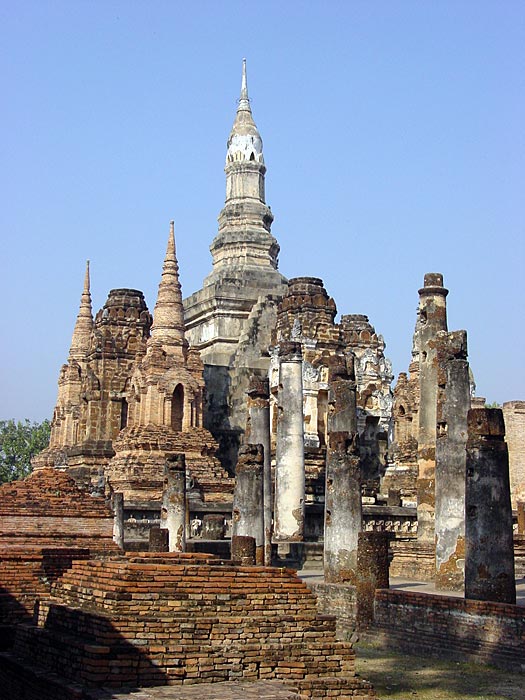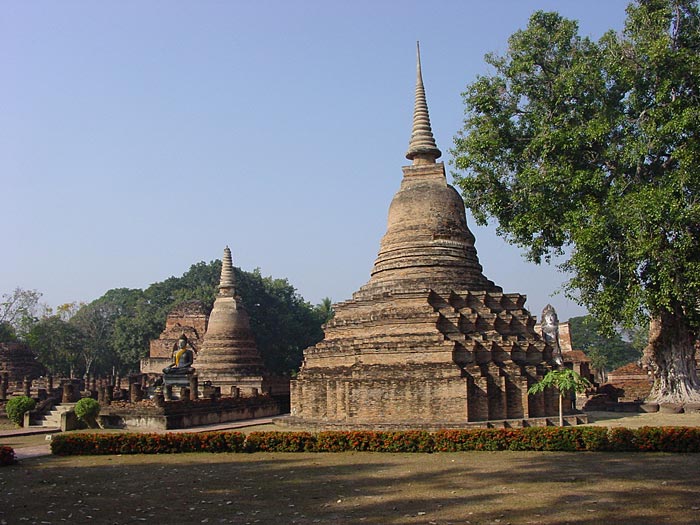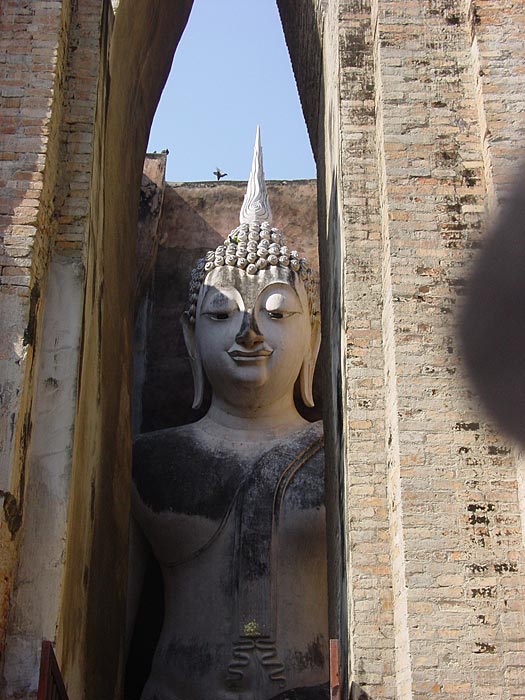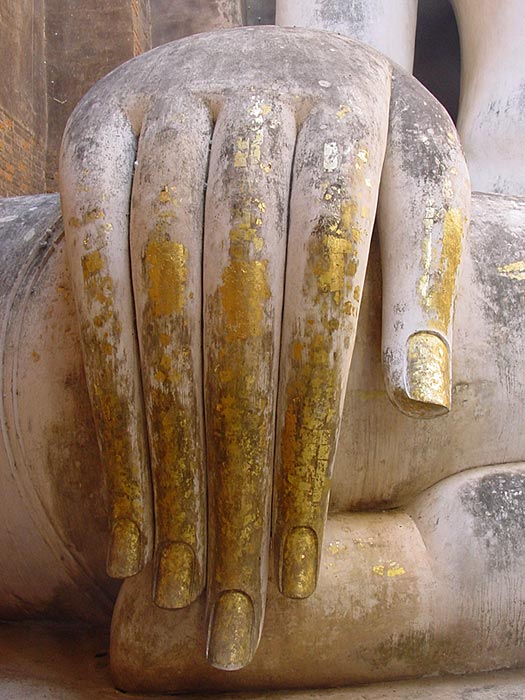Sukhothai Historical Park
Sukhothai Historical Park is a World Heritage Site. Important ancient monuments are contained within the old city walls and outside the city walls.
A characteristic feature of Sukhothai temple architecture is the lotus-bud chedi. It features a conical spire finial on a square-sided structure on top of a three-tiered base. However at Sukhothai also Sri Lankan and Srivijaya style monuments are present. Most of the temple structures in Sukhothai Historical Park were constructed during the Kingdom of Sukhothai era (from around 1235-1438 A.D.)

Main temple group at Wat Mahathat, Sukhothai ancient city.
Inside the old city walls, Wat Mahathat occupies the largest area. It is a monastery about 200 meters square in size. Many original Buddha images are still present among the ruins. The compound contains no less than 198 chedis. The temple structures are described on the famous Sukhothai Stone Inscriptions.
Wat Si Sawai is located about 350 meters south of Wat Mahathat. Its three prangs were built in Lopburi style. Lintels, fragments of Hindu images and a linga indicate that the temple was initially a Hindu sanctuary. It was later transformed into a Buddhist temple.

Chedi at Wat Mahathat, Sukhothai Historical Park
Wat Sa Si is northwest of Wat Mahathat. Its round stupa serves as historical evidence of the influence of Sri Lankan (Sinhalese) Buddhism in old Sukhothai.
Outside the old city walls, Wat Phra Phai Luang is located close to the northern gate. It contains a group of ancient monuments of great significance. Among its many structures, it originally contained three buildings in prasat style. One of them is remaining and is adorned with stuccoed reliefs depicting the life of the Buddha. Its art details indicate that Sukhothai had cultural contact with the Khmer empire in the reign of Jayavarman VII and was also associated with Lavo (Lopburi), then a Khmer town of great importance in the central plain of Thailand.

Phra Atchana (Ajana) at Wat Si Chum, Sukhothai Historical Park
Northwest of the city wall, Wat Si Chum is much visited and contains a well known large sitting Buddha image. The image is also mentioned in the Sukhothai Stone Inscription No.1, and Phra Atchana (Ajana) is the name of the Buddha image. There are ancient drawings on the ceiling of the mandapa surrounding the Buddha, telling the stories of the former incarnations of the Buddha (Jatakas).
Wat Chang Lom is located east of the City. Similar temple compounds are present at Si Satchanalai and Kamphaeng Phet. The temple consists of a main bell-shaped chedi with 32 elephant statues around its base.
Besides the temples described there are many other temple structures scattered around old Sukhothai. It is best to hire a bicycle (easily available) to spend time visiting the sites.

Detail of Hand, Phra Atchana, Wat Si Chum, Sukhothai Historical Park
Ramkhamhaeng National Museum is located within walking distance of Wat Mahathat. It is a good starting point for an exploration of the ruins. A replica of the famous Ramkhamhaeng inscription is kept here among a good collection of Sukhothai artifacts. You can see different Buddha images with different styles and origins. For linguists, there is a very nice section showing the evolution in time of Thai, Khmer, Mon scripts. King Ramkhamhaeng is credited with originating the original Thai written language.
The importance of Sukhothai in Thai history can not be understated. While the kingdom did not last that long in time, at the height of its power, its influence covered an area actually larger than present day Thailand. To the west its influence reached Pegu and Martaban. To the south, to present day Nakhon Si Thammarat. To the north, to Luang Prabang (present day Laos). This influence was not only gained by battle field conquests, but in large part by diplomacy, intermarriage in a pattern of political relationships based on vassals and overlords. Sukhothai however was not a state in the present day meaning of the word. Many parts of the kingdom retained important local power, while submitting themselves to Sukhothai.

